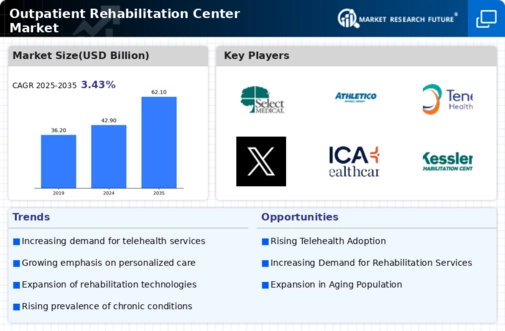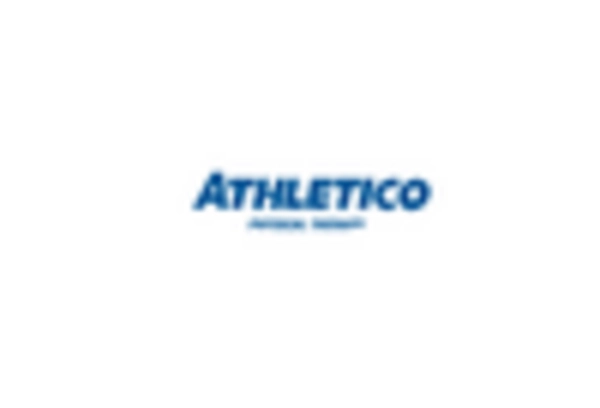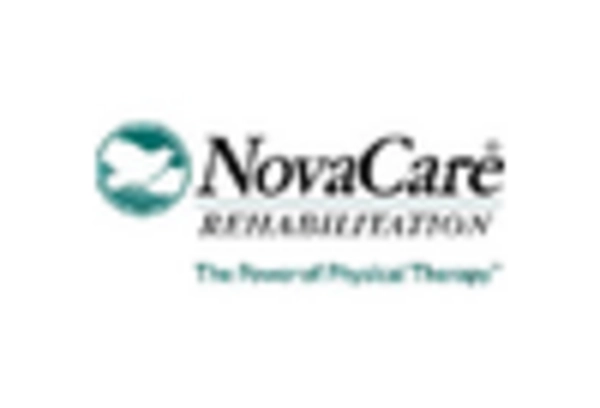Aging Population
The aging population is a primary driver of the Outpatient Rehabilitation Center Market. As individuals age, they often experience a decline in physical health, leading to increased demand for rehabilitation services. According to recent statistics, the population aged 65 and older is projected to reach 1.5 billion by 2050, which suggests a substantial rise in the need for outpatient rehabilitation services. This demographic shift indicates that outpatient rehabilitation centers will likely see a surge in patients requiring physical therapy, occupational therapy, and other rehabilitation services. Furthermore, older adults often have multiple chronic conditions, necessitating comprehensive rehabilitation programs tailored to their specific needs. Thus, the aging population is a critical factor influencing the growth and evolution of the Outpatient Rehabilitation Center Market.
Technological Advancements
Technological advancements are reshaping the landscape of the Outpatient Rehabilitation Center Market. Innovations such as telehealth, wearable devices, and virtual reality are enhancing the delivery of rehabilitation services. Telehealth, in particular, has gained traction, allowing patients to access therapy remotely, which is especially beneficial for those with mobility issues or those living in rural areas. The integration of wearable technology enables real-time monitoring of patient progress, facilitating personalized treatment plans. Furthermore, virtual reality applications are being utilized to create immersive rehabilitation experiences, improving patient engagement and outcomes. As these technologies continue to evolve, they are likely to attract more patients to outpatient rehabilitation centers, thereby driving market growth. The ongoing investment in technological solutions suggests a promising future for the Outpatient Rehabilitation Center Market.
Rising Healthcare Expenditure
Rising healthcare expenditure is a notable driver of the Outpatient Rehabilitation Center Market. As healthcare spending continues to increase, more resources are allocated to rehabilitation services, reflecting a growing recognition of their value in patient recovery and quality of life. In many regions, healthcare expenditure has been rising at an annual rate of 5% or more, which suggests that outpatient rehabilitation services are becoming a priority within healthcare budgets. This trend is likely to enhance the availability and quality of rehabilitation services, as facilities invest in better equipment, staff training, and innovative treatment methods. Furthermore, increased funding for outpatient rehabilitation can lead to expanded access for patients, thereby driving demand. Consequently, rising healthcare expenditure is a critical factor influencing the growth trajectory of the Outpatient Rehabilitation Center Market.
Increased Focus on Preventive Care
An increased focus on preventive care is emerging as a significant driver of the Outpatient Rehabilitation Center Market. Healthcare systems are increasingly recognizing the importance of early intervention and rehabilitation in preventing the progression of diseases and improving overall health outcomes. This shift towards preventive care is likely to lead to a higher demand for outpatient rehabilitation services, as patients seek to address health issues before they escalate. Moreover, insurance providers are beginning to cover preventive rehabilitation services, making them more accessible to a broader population. This trend aligns with the growing emphasis on holistic health approaches, which prioritize patient well-being and functional independence. As a result, the increased focus on preventive care is expected to play a crucial role in shaping the future of the Outpatient Rehabilitation Center Market.
Rising Prevalence of Chronic Diseases
The rising prevalence of chronic diseases is significantly impacting the Outpatient Rehabilitation Center Market. Conditions such as diabetes, heart disease, and obesity are becoming increasingly common, leading to a heightened need for rehabilitation services. Data indicates that approximately 60% of adults in developed nations are living with at least one chronic condition, which often requires ongoing rehabilitation to manage symptoms and improve quality of life. This trend is likely to drive demand for outpatient rehabilitation services, as patients seek to regain functionality and independence. Additionally, the focus on preventive care and early intervention may further bolster the outpatient rehabilitation sector, as healthcare systems aim to reduce hospital admissions and improve patient outcomes. Consequently, the rising prevalence of chronic diseases is a pivotal driver of growth within the Outpatient Rehabilitation Center Market.


















Leave a Comment